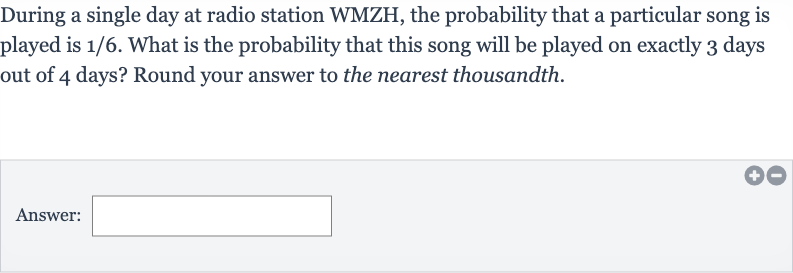AI tutor
Welcome to Bytelearn!
Let’s check out your problem:

During a single day at radio station WMZH, the probability that a particular song is played is . What is the probability that this song will be played on exactly days out of days? Round your answer to the nearest thousandth.Answer:
Full solution
Q. During a single day at radio station WMZH, the probability that a particular song is played is . What is the probability that this song will be played on exactly days out of days? Round your answer to the nearest thousandth.Answer:
- Understand and Determine Probability: Understand the problem and determine the probability of the song being played on any given day.The probability of the song being played on a single day is given as . We need to find the probability of this event happening exactly times in a sequence of days.
- Use Binomial Probability Formula: Use the binomial probability formula to calculate the probability of the song being played exactly times in days.The binomial probability formula is , where:- is the probability of successes in trials,- is the binomial coefficient,- is the probability of success on a single trial, and- is the probability of failure on a single trial.In this case, , , and .
- Calculate Binomial Coefficient: Calculate the binomial coefficient ..
- Calculate Probability of Times: Calculate the probability of the song being played exactly times.Using the binomial probability formula:
- Perform Calculations: Perform the calculations.
- Simplify Fraction and Round: Simplify the fraction and round to the nearest thousandth. can be simplified to .To round to the nearest thousandth, we convert to a decimal.Rounded to the nearest thousandth, this is approximately .
More problems from Find probabilities using the binomial distribution
QuestionGet tutor help
QuestionGet tutor help
QuestionGet tutor help
QuestionGet tutor help
QuestionGet tutor help
QuestionGet tutor help
QuestionGet tutor help
QuestionGet tutor help
QuestionGet tutor help
QuestionGet tutor help
